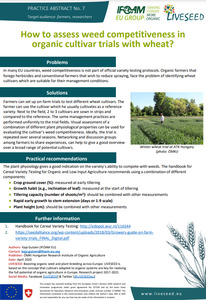{Tool} How to assess weed competitiveness in organic cultivar trials with wheat? (Liveseed Practice Abstract). Creator(s): Gutzen, Kaja. Issuing Organisation(s): IFOAM Organics Europe, ÖMKi - Hungarian Research Institute of Organic Agriculture. Liveseed Practice Abstract, no. 7. (2020)
|
PDF
- English
(How to assess weed competitiveness in organic cultivar trials with wheat?)
1MB | |
![[thumbnail of 2022-07-26 20_31_20-PowerPoint Presentation.png]](/38980/3.hassmallThumbnailVersion/2022-07-26%2020_31_20-PowerPoint%20Presentation.png)  Preview |
Image (PNG)
- Cover Image
- English
215kB |
Document available online at: https://www.liveseed.eu/wp-content/uploads/2020/11/PA7_How-to-assess-weed-competitiveness-in-organic-cultivar-trials-with-wheat.pdf
Summary in the original language of the document
Practical recommendations: The plant physiology gives a good indication on the variety’s ability to compete with weeds. The handbook for Cereal Variety Testing for Organic and Low Input Agriculture recommends using a combination of different components: Crop ground cover (%): measured at early tillering, Growth habit (e.g., inclination of leaf): measured at the start of tillering, Tillering capacity (number of shoots/m2) should be combined with other measurements, Rapid early growth to stem extension (days or 1-9 scale), Plant height (cm): should be combined with other measurements.
| EPrint Type: | Practice tool |
|---|---|
| Teaser: | Assess weed competitiveness! |
| What problem does the tool address?: | In many EU countries, weed competitiveness is not part of official variety testing protocols. Organic farmers that forego herbicides and conventional farmers that wish to reduce spraying, face the problem of identifying wheat cultivars that are suitable for their management conditions. |
| What solution does the tool offer?: | Farmers can set up on-farm trials to test different wheat cultivars. The farmer can use the cultivar which he usually cultivates as a reference variety. Next to the field, 2 to 3 cultivars are sown in strips and compared to the reference. The same management practices are performed uniformly to the trial fields. Visual assessment of a combination of different plant physiological properties can be used for evaluating the cultivar’s weed competitiveness. Ideally, the trial is repeated over several seasons. Networking and discussion groups among farmers to share experiences can help to give a good overview over a broad range of potential cultivars. |
| Country: | Belgium |
| Type of Practice Tool: | Practice abstracts |
| Agrovoc keywords: | Language Value URI English breeding http://aims.fao.org/aos/agrovoc/c_49902 English plant breeding http://aims.fao.org/aos/agrovoc/c_5956 English wheat http://aims.fao.org/aos/agrovoc/c_8373 |
| Subjects: | Crop husbandry > Breeding, genetics and propagation |
| Research affiliation: | European Union > Horizon 2020 > Liveseed European Union > Horizon 2020 > Liveseed > Liveseed tools Hungary > Hungarian Research Institute of Organic Agriculture International Organizations > International Federation of Organic Agriculture Movements IFOAM > IFOAM Organics Europe European Union > Organic Farm Knowledge |
| Horizon Europe or H2020 Grant Agreement Number: | 727230 |
| Related Links: | https://organic-farmknowledge.org/tool/38980, https://www.organicseurope.bio/, https://www.biokutatas.hu/ |
| Project ID: | ofk |
| Deposited By: | Ortolani, Dr. Livia |
| ID Code: | 38980 |
| Deposited On: | 14 Feb 2021 09:16 |
| Last Modified: | 02 May 2024 10:32 |
| Document Language: | English |
| Status: | Published |
Repository Staff Only: item control page

 Download Statistics
Download Statistics Download Statistics
Download Statistics
